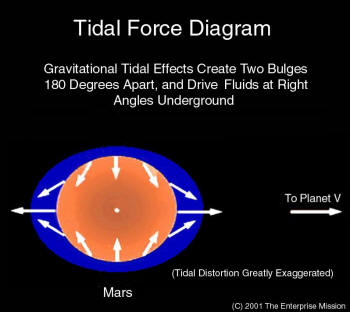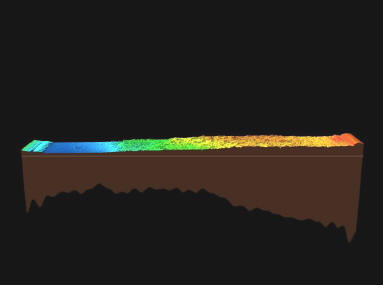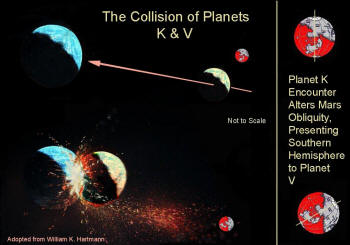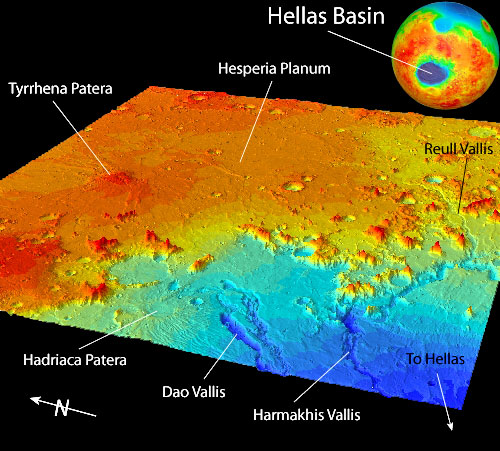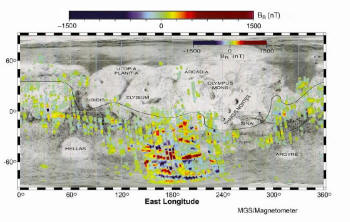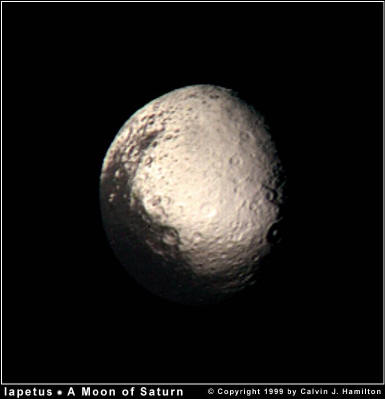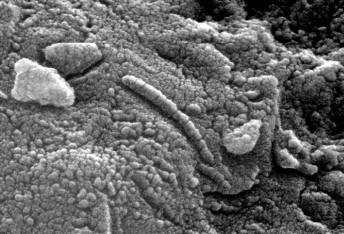|
Stain Distribution
A major, long-term consequence of this eventual Mars synchronous rotation around Planet V is the present bi-modal distribution of subsurface water stains. The tidal forces from Planet V would have pushed water into sub-crustal fissures and cavities at right angles to the exerted tidal stress between Mars and Planet V (Figure 17).
Over time, this would have driven additional Martian water in between the two “tidal oceans” deep underground and toward one of the two “water poles” at either end of the line connecting Mars with Planet V. Figure 17 Water is forced into sub-crustal cavities in the ocean beds by the tidal forces exerted by Planet V at right angles to the lines of force
This important theoretical detail is neatly confirmed by the crucial
observation that the stain flow images are clustered only in the
Tharsis region and Arabia, exactly 180 degrees opposite. Any water
apparently residing in between these two locations seems to have
been driven underground by the proposed tidal stresses on the
planet. So deep, in fact, that it is now unable to leave any surface
indications between these two former tidal “poles.”
If the material making up the more heavily cratered southern hemisphere is due to superimposed material on the smoother, more eroded original crust (Figure 18), then we would likely not now find much water near the surface in those regions – even under the former Tharsis tidal ocean.
Figure 18 MOLA generated 3D topography strip showing the dramatic difference in crustal elevation between the heavily cratered southern highlands and the smoother northern lowlands.
Possible water stain
images appear only above the crustal “line of dichotomy.” The exception to this pattern would appear to be the location of the opposite “tidal ocean” – the Arabia Terra plateau, which is heavily cratered as if from the Planet V event, but possesses the second highest number of current water stain images (see Figure 5). Recent scans from MOLA have shown that the crust is significantly thinner in Arabia than it is in most of the cratered southern hemisphere,30 accounting for the presence of relatively shallow water seepages beneath this former ocean.
Additionally, researchers Brian Hynek and Roger Phillips from Washington University in St. Louis, interpreting this new altimeter evidence from Mars Observer, conclude that an enormous amount of surface material was somehow excavated from the planet's western Arabia Terra region.31
According to Hynek, the most likely erosional force of this magnitude is flowing water.
Their puzzling observations are neatly explained by the sudden collapse of a former “tidal ocean” previously maintained by Planet V. When Planet V “exploded,” a massive wall of water would have been released in a few hours, rushing northward – taking a good deal of Arabia Terra with it in the process – exactly as Hynek and Phillips now conclude.
This, of
course, also explains the current surface presence of stain images
in this region – they are the exhumed underground remains of the
subsurface waters from this former “Arabia Ocean.”
We have freely used the phrase in this
paper “when Planet V exploded" to describe the eventual
disappearance of Planet V and the release of Mars back into a
heliocentric (solar) orbit.
This insistence on a heretofore
unmodeled, “mysterious energy release” mechanism has played a major
role in Van Flandern’s less than enthusiastic reception by the
planetary science community, in spite of the many other recent
confirmations of his model. Since the evidence Van Flandern has
marshaled for the after effects of this Event is far more important
here than the precise destruction mechanism he’s proposed, we
believe a shift of emphasis could retain the best features in this
instance, while avoiding the non-testable aspects of Van Flandern’s
original EPH model
In 1975, Drs. William K. Hartmann and Donald R. Davis, writing in ICARUS, suggested that the Moon was formed as a side effect of a catastrophic “glancing collision” of the Earth with another major planetary object. Their idea was that “a Mars-sized planetisimal” collided with the early Earth, spalling off enough lightweight crustal material to recondense to form the Moon. In 1984, the first planetary conference to specifically consider all aspects of this revolutionary theory was convened, titled “Origin of the Moon.” 32
It is our proposal that a similar event,
simply delayed by a quirk of celestial mechanics until very late in
solar system history, precipitated the destruction of two planets in
the current Asteroid Belt ~65MYA. This event, we suggest, thus
liberated Mars from its temporary synchronous orbit of Planet V to
once again pursue a solitary – if significantly more elliptical than
any other inner planet -- solar orbit.
To probe this cycle’s influence on Earth's climate over the past 100 million years, Runnegar’s team constructed computer models based on known variations in planetary orbits, their proximity to the Sun and their interactive perturbations. In running the models, they found that the known fluctuations of the solar system's dynamics remained constant going back to 65 million years ago.
Then, to their surprise, the frequency of perturbations to the orbits of the inner planets suddenly changed.33
Or, maybe they were being formed – in a gargantuan collision. Aspects of this model echo another source of surprising information about the solar system: cuneiform records from the earliest “high” civilization, the Sumerian.
Zecharia Sitchin has written extensively
about the Sumerian’s uncanny “knowledge” of possible collisional
events from this earliest period of solar system history.34 With the
latest discoveries of radically different extra solar planetary
systems and current theoretical efforts to understand these systems
in terms of potentially interacting planetary orbits, the relevance
of Sitchin’s Sumerian translations should take on new meaning.
Assuming that only the top 1% of Planet V and K’s lithospheres survived this disruptive Event -- as accelerated chunks of various- sized crustal debris moving outward from the site of the collision -- large amounts of much smaller materials from the exposed high temperature mantles and cores of the respective planets would have been ejected at high speed directly towards Mars in this Event.
In looking for resulting evidence of
their impacts on Mars, we should expect to see signatures of rapid
surface heating and then freezing; catastrophic water and associated
mudflows; a major loss of atmosphere along with huge quantities of
water; and finally – hemispherical cratering on Mars from a vast
amount of blast debris from Planet V.
Simple Newton’s Laws:
So, what is our solution? Figure 19 Proposed collision event of planets V and K. Close approach of planet K alters Mars obliquity, resulting in a debris splatter pattern 60 degrees to previous (and current) spin axis
After initiating this first major change in Mars’ orientation in perhaps several hundred million years, Planet K continued inward toward it’s catastrophic rendezvous with Planet V. This impact initiated an almost inconceivable release of energy – the equivalent of Van Flandern’s EPH explosion – and the shattered fragments of the crust of both worlds, accelerated by the enormous blast, began their spherical, outward journey through the solar system. Some of them, a tiny fraction of the total mass of both exploding planets, in the space of a few hours eventually reached Mars.
But, by the time the first major wave of fragments had arrived, Mars had tipped over by some ~60 degrees, presenting almost the entire southern hemisphere to the “explosion.” That’s why the “line of dichotomy” is tilted by that ~60 degrees, relative to Mars spin axis. In fact, as Mars continued to heel over and larger, slower fragments continued to arrive, this was when the material which partially covered Arabia Terra reached the planet.
Shortly after that, the largest, continent-sized fragment -- which created the 2300 kilometer wide, 5 kilometer deep Hellas basin, the largest on the planet Mars – impacted south of Arabia Terra (Figure 20).36 Figure 20 Hellas’ 2300 km impact basin
Hellas Basin
Approximately 12 hours since the collision of Planet’s K and V had
now elapsed.
Any surface waters would literally boil
from the shockwaves and radiant heating of incoming high-velocity
debris, and a major fraction of that water would then join the
atmosphere in its escape. With the immediate loss of a significant
percentage of the atmosphere, temperatures on the surface would
plummet, resulting in any remaining liquid water quickly freezing.
Shallow underground reservoirs would remain liquid for a longer
interval, before also becoming ice.
Several current
geochemical puzzles regarding Mars are solved with the introduction
of this “Martian satellite model.” When Viking carried out the first insitu surface composition measurements in 1976, one of the puzzling
results was an unusually high percentage of sulfur in the soil.
Compared to an average surface abundance on Earth of 0.07%, Viking
reported a Mars sulfur abundance of over 3% -- 43 times more.
Similarly, iron on the surface of the Earth is 3.8%, while on the
surface of Mars it measures over 15%.37
Mars redness, we now know from TES data,39 results from the extensive drifts of iron oxide strewn across the surface. A fundamental question then becomes: if the original iron source was metallic iron, from the exploding/colliding planets’ cores, where did the free oxygen come from to eventually oxidize that iron down on Mars? Even primordial free oxygen, capable of oxidizing iron in geological strata termed “banded-iron formations” and “red beds” on Earth, it is agreed, derived from one main source: growing biological activity.40
Mars Global Surveyor surface composition data indicates another major surface anomaly on Mars that supports this tidal model. Using the information from TES, Robert N. Clarke and Todd M. Hoefen, of the U.S. Geological Survey, have reported the identification of widespread abundances of olivine [(Mg, Fe)2 SiO4] on the Martian surface (Figure 21).41 Figure 21 Mars global Olivine distribution (Blue) (USGS)
As olivine (an iron-magnesium silicate) quickly weathers into other minerals in the presence of liquid water, its surprising abundance according to all conventional Mars models would indicate that the planet has been “cold and dry” for the last several billion years. It’s widespread presence, according to Clark, seems to effectively preclude former models of a “warmer, wetter Mars.”
Our interpretation is quite different: that the source of
Mars’
olivine (like its anomalous iron and sulfur) is totally external
-- also coming from the destruction of Planet V, rather than from
conventional internal ancient volcanism.
And that Mars inevitably swept up a
significant amount of this rapidly condensed material. Because Mars’
climate radically changed immediately after this Event, and its
remaining water froze, the presence of large quantities of
unweathered olivine on Mars can only be another striking signature
of Mars’ former existence as a satellite of Planet V -- which (the
olivine confirms) was then catastrophically destroyed. Figure 22 Water stain map superimposed over Olivine distribution map
On a planet otherwise exhibiting abundant evidence of extensive water flows and its attendant weathering of olivine, how can the current surface distribution of this mineral support an ancient southern hemisphere? The answer is: it can’t.
Thus, we take this wide-spread olivine as strong confirmation that,
More precisely, that it’s simply accreted mantle material from the disintegration of Planet’s K& V.
Point number two: by overlaying Palermo’s “stain global distribution” with the USGS TES mineral map from Clark and Hoe-fen, we can easily assess the second correlation. As one can see (Figure 22), the “water stain” image clusters occupy – almost exclusively – areas with little or no olivine. This is also entirely consistent with the model we’ve proposed, that these stains are evidence of current, extensive, ground-based liquid water.
Further corroborating evidence for this dramatic sequence of events comes from additional TES data. As reported in SCIENCE,42 two distinct surface spectral signatures have now been identified on Mars from low-albedo regions of the planet. Comparisons with spectra of terrestrial rock samples indicate that the two compositions are a basaltic mix dominated by plagioclase feldspar and clinopyroxene, and an andesitic (silicic) composition dominated by plagioclase feldspar and volcanic glass.
The distribution of these two distinct
mineral compositions is, again, split roughly along the planetary
dichotomy line. The basaltic composition is confined to the heavily
cratered terrain in the south, and the more silicic composition is
concentrated in the northern plains.
The theory is that it in fact dates back
to the earliest history of Mars, when the first massive basaltic
volcanism was forming surface crust. In this view, the (presumed)
remnants of the last heavy meteor bombardment are also represented
on this “primitive” southern hemisphere, by the extensive cratering
below the “line of dichotomy.” This overwhelmingly crater-covered
landscape, in this theory, simply confirms the idea that this is
truly ancient “3+GYA” original Martian crust.
The more weathered northern plains, according to TES
data, also confirm – contrary to all the conventional Mars models --
that it is in fact the older hemisphere of Mars, and was long
exposed to the erosive and weathering effects of liquid water … if
not perhaps free oxygen.
Phillips reports that the Tharsis
rise is the result of 300 hundred million cubic kilometers of lava
-- enough to cover Mars 2 kilometers deep, if spread evenly across
the planet -- that somehow became concentrated in one place on Mars.
This calculation is far greater than previous estimates from past
studies.43 Figure 23 The “Tharsis Trough” (MOLA)
Phillips says,
The authors – in light of the tidal model presented in this paper --
have a very different interpretation of these associated features.
The “Tharsis trough” around this massive
concentration of material is merely the result of an inevitable
depression in the Martian crust around this ponderous mass (Figure
23 above), as that crust has broken and sunk under the enormous (now
unsupported) weight of Tharsis, attempting to come to a new
equilibrium condition.
Over time, the enormous potential energy
released within the mantle from the partial downward readjustment of
Tharsis and Arabia caused a “pulse” of major heating inside Mars
where the internal forces balanced. The result, 90 degrees in
between, was the creation of a much later, much smaller volcanic
uplift --Elysium Mons.
For many years the question
has remained: does Mars (like all the other planets measured)
possess an intrinsic magnetic field? This question is important to
geologists and biologists alike. For, if Mars has (or had) a sizable
magnetic field, then the evolution of the planet would have been far
more benign for the development of life. Mars Surveyor, beginning in
1997, finally gave an answer to this question: no. The core
mechanism which would support an active Martian magnetic field
generation process, like in the Earth or Jupiter, has died --
leaving only a remnant surface field from an ancient dynamo to be
detected. Figure 24 Mars magnetic field striping distribution. (NASA/MSSS)
The stripes represent areas of Mars’
ancient “frozen field,” recorded in magnetized “strips” of Martian
crust, alternating in polarity – North/South – until they reach the
“line of dichotomy,” where they then mysteriously dissipate.44 Two
important additional facts: the bands do not extend into the
northern plains; and, they also mysteriously stop at the locations
of the huge Argyre and Hellas impact basins.
These workers immediately equated the banding (in their model) with the process being “very ancient’ -- dating back to the original formation of Mars’ basaltic crust. The main problem with this model: the Mars’ banding is far larger than the suggested parallels on Earth, and there seems to be no “point of symmetry” from which the upwelling lava spread out in both directions, unlike undersea ridges here on Earth which are creating new seafloor in this process.45
We suggest a completely different origin.
One explanation was that the dry, upper
layers of the Moon efficiently transmitted the impact energy
(equivalent to 1600 lbs of TNT) of the impacting LM, as a set of
standing waves around the Moon, first increasing and then decreasing
in intensity as the energy was reflected between two upper layers of
the lunar crust. We propose a similar phenomenon – but at an
incalculably greater intensity – occurred on Mars as a direct result
of the barrage of impacts that blanketed the southern hemisphere
from the destruction of Planet V.
As a further confirmation of our model, we point to the “anomaly” of Argyre and Hellas. The MGS magnetic survey discovered that the “banding” stops at the site of these two major impact basins. We propose a simple and elegant explanation for this important observation: in keeping with basic Newtonian physics, which constrains these largest fragments of Planets K&V to arrive last, it is consistent with this model that when these massive, slowly-moving impactors arrived and excavated their respective basins, their colossal collisional energy destroyed the delicate “standing wave” conditions for preserving the magnetic banding from the previous debris.
They also raised the local material
above their Curie point again, literally melting any cooling bands
which had previously formed in these locations. In this way, the
absence of magnetic signatures around these two major impact sites
confirms that they had to have arrived last.
We further submit that the complete
absence of any similar phenomenon elsewhere on Mars – north of the
impact “line of dichotomy” -- is compelling evidence for this
hypothesis. And finally, this key indication of Mars’ former active
magnetic field, inferred from the strength of the “frozen field”
magnetic bands -- approximately 1/400th Earth’s current surface
field – is more than sufficient to have encouraged a viable Martian
biological environment … in recent times.
In Van Flandern’s original celestial
mechanics model for the EPH, his analysis of the orbits of
long-period comets strongly implied another, far more recent
“explosion event” than the one we’ve been discussing here.49
Van Flandern proposed a second
satellite of Planet V as the cause of these new comets, which was
destroyed in a similar manner to Planet V, but after several million
years. Calculations showed that after Planet V was shattered and its
determining gravitational field disappeared, Mars and this second
satellite could have gone into an orbit around each other. According
to Van Flandern, such a second orbital capture had “about a
fifty/fifty chance,” of taking place.50
Because of later interactions with
Jupiter, the primary debris of the original collision would have
been diverted into orbits which eventually crossed the orbits of all
the other planets in the solar system. This (according to Van
Flandern) is why there are so many recent impact craters on solar
system objects; they stem from the debris of this 65 MYA Event,
“mopped up” by subsequent collisions throughout the solar system.
But, unlike Van Flandern’s reconstruction, we do not believe that such an event necessarily took place in the immediate vicinity of Mars. Van Flandern believes that Mars and the “second moon” had to have been orbiting each other, primarily because the massive evidence of “late” water flows on Mars and a presumed high water content for the composition of this “second moon.”
In our model, because of the tidal
release of vast reservoirs of Martian water after Planet V was gone
(water not known to Van Flandern when he first proposed his model),
we believe the fluvial signatures he ascribes to the destruction of
this second, “Europa-type” moon were all created 62 million years
earlier, in the immediate aftermath of the Planet V destruction at
65 MYA.
The catastrophic destruction of a moon or
major planet – either through collision or explosion – could not
take place without leaving major signatures far beyond its immediate
vicinity. One potential signature -- the peculiar orbits of the
long-period comets – was the data that initially awakened Van Flandern’s interest in this subject. But there are other indicators
that now amply support the model of a former “tidal Mars,” and the
catastrophic destruction of its foster parent.
Because of the satellite’s slow, almost 80-day tidally locked rotation/revolution around Saturn, the debris – passing Iapetus in only a few hours -- impacted essentially on the facing side of Iapetus – resulting in one of the most asymmetrical objects in the solar system.51
Figure 25
Saturn’s moon Iapetus,
pitch black on one side as if from a blast wave.
The extraordinary events occurring at
the end of the Cretaceous Period (~65MYA) on Earth is also on this
list. From the sudden extinction of the dinosaurs and 50% of all
other species, to the world-wide layers of iridium and soot that are
now evidence of an extraterrestrial impact of unimaginable global
scope, the destruction of Planet V obviously also left its tragic
mark as far away as Earth.52 It is now apparent that the object
which struck this planet ~65 MYA and triggered a wave of
catastrophic mass extinctions, most likely occurred as a direct
result of the impact of a large (~10 km) fragment from Planets K&V.
But what of later impacts?
But this theory is not without its critics, among them Tom Van Flandern.
In other words, without the model of
colliding/exploding Planets K& V, the only possible origin for such
“anomalous meteorites” - in the minds of most researchers -- is the
planet Mars. With the substantive evidence for other, destroyed
planetary bodies in this region of the solar system – now implicit
in the Mars tidal model we’ve presented – serious alternatives for
the origin of currently identified “Martian meteorites” present
themselves.
This water, trapped within some rare
meteorite structures, would be expected to contain salt (sodium
chloride) from run-off minerals dissolved from potential continental
portions of the former planet(s). “The existence of a water-soluble
salt in this meteorite is astonishing,” wrote R.N. Clayton of the
University of Chicago.58 For all conventional (primordial)
high-temperature models of asteroid formation, this discovery truly
is impossible. Only the trapping of Mars as a former satellite, and
its release with the disintegration of Planets K&V, contains this
specific discovery as an implicit aspect of the model.
Moore and his team, in re-analyzing
their meteorites, concluded the excess chlorine could easily have
resulted from saltwater leaking in. Moore sees these elements as
potential tracers of “an early Martian ocean,” infused with salt
compounds much like Earth’s own.59 This elevated presence of salts
and salt compounds in the SNCs, as compared with other meteorites,
in our model simply comes from another ocean – one on Planets K or
V. Thus, the elevated presence of water-soluble salts in SNCs is
also remarkably consistent with the model we’ve presented.
The discoverers were at a loss to explain this unique feature, simply saying in their announcement,
One of the authors (Hoagland) immediately realized that this signature, while extremely puzzling to most astronomers and planetologists, was totally consistent with the EPH hypothesis, and could easily be explained by an unseen parent molecule within the new tail: sodium chloride.
In other words, if Hale-Bopp was another fragment of the disrupted planet/moon that Van Flandern initially pointed out over twenty years ago, then the discovery of sodium strongly implied that this comet parent body also had an ocean – and Hale-Bopp was simply another fragment of that planet. He promptly informed Van Flandern of his hypothesis.62
|
